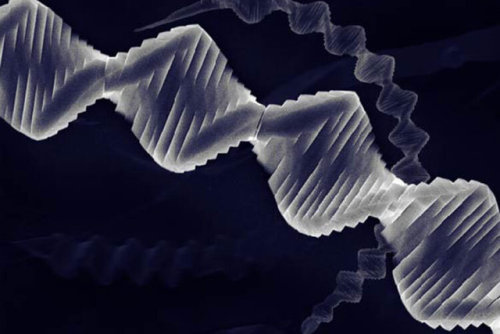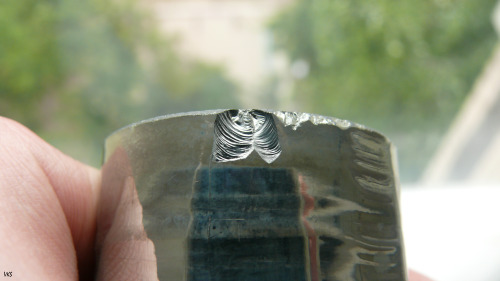#germanium
Until pure silicon became widely available in the 1950s, germanium was the element used in most semiconductors.
Researchers improve semiconductor laser on silicon
Electrical engineering researchers have boosted the operating temperature of a promising new semiconductor laser on silicon substrate, moving it one step closer to possible commercial application.
The development of an “optically pumped” laser, made of germanium tin grown on silicon substrates, could lead to faster micro-processing speed of computer chips, sensors, cameras and other electronic devices—at much lower cost.
“In a relatively short time period—roughly two years—we’ve progressed from 110 Kelvin to a record temperature of 270K,” said Shui-Qing “Fisher” Yu, associate professor of electrical engineering. “We are now very close to room-temperature operation and moving quickly toward the application of a material that can significantly increase processing speed with much less power consumption.”
Yu leads a multi-institutional team of researchers on developing a laser injected with light, similar to an injection of electrical current. The improved laser covers a broader wavelength range, from 2 to 3 micrometers, and uses a lower lasing threshold, while capable of operating at 270 Kelvin, which is roughly 26 Farenheit.
Post link
Crystal with a twist: scientists grow spiraling new material
With a simple twist of the fingers, one can create a beautiful spiral from a deck of cards. In the same way, scientists at the University of California, Berkeley, and Lawrence Berkeley National Laboratory (Berkeley Lab) have created new inorganic crystals made of stacks of atomically thin sheets that unexpectedly spiral like a nanoscale card deck.
Their surprising structures, reported in a new study appearing online Wednesday, June 20, in the journal Nature, may yield unique optical, electronic and thermal properties, including superconductivity, the researchers say.
These helical crystals are made of stacked layers of germanium sulfide, a semiconductor material that, like graphene, readily forms sheets that are only a few atoms or even a single atom thick. Such “nanosheets” are usually referred to as “2-D materials.”
“No one expected 2-D materials to grow in such a way. It’s like a surprise gift,” said Jie Yao, an assistant professor of materials science and engineering at UC Berkeley. “We believe that it may bring great opportunities for materials research.”
Post link
Lithium-ion batteries will get more efficiency due to silicon, germanium, carbon nanowalls
Members of the D. V. Skobeltsyn Institute of Nuclear Physic and colleagues from the Faculty of Chemistry of the Lomonosov Moscow State University have developed a new silicon- and germanium-based material that could significantly increase specific characteristics of lithium-ion batteries. The research results have been published in the Journal of Materials Chemistry A.
Lithium-ion batteries are the most popular type of energy storage system for modern electronic devices. They are composed of two electrodes—the negative (anode) and positive (cathode) ones, which are placed into a hermetic enclosure. The space in between is filled with a porous separator, steeped in a lithium ion-conductive electrolyte solution. The separator prevents short circuits between the bipolar electrodes and provides electrolyte volume, necessary for ion transport. Electric current in an external circuit is generated when lithium ions extract from the anode material and move through the electrolyte with further insertion into cathode material. However, the specific capacity of a lithium-ion battery is largely defined by the number of lithium ions that can be accepted and transferred by active materials of the anode and cathode.
The scientists have developed and studied a new anode material that allows energy efficiency of Li-ion batteries to be significantly increased. The material is suitable for utilization in both bulk and thin film Li-ion batteries.
Post link
Researchers developing 2-D materials similar to graphene
Chemists are working to synthesize the next generation of super materials for high-performance electronics, solar cells, photodetectors and quantum computers. While they have made progress with compound materials, they have not yet succeeded in developing unaltered or “freestanding” materials for such devices, according to a review published in the journal Science and Technology of Advanced Materials.
Graphene is a carbon material derived from graphite, the same type of material found in pencils, but it is arranged in a one-atom-thin honeycomb lattice. Discovered in 2004, graphene’s two-dimensional arrangement gives it “extraordinary” properties, including extreme strength and “marvelously high” electron conductivity.
However, the tight lattice lacks a semiconducting bandgap, which is essential for electronic devices. Therefore, scientists have been hunting for alternative materials that have bandgaps, but still have a graphene-like structure.
Much focus has been placed on graphene quantum dots, which are small segments of graphene, about 10 to 100 nm carbon hexagons across and less than 30 atomic sheets thick. To make the dots behave more like 2-D graphene, research teams have added other molecules to change the structure and function of the material.
Post link
Making ferromagnets stronger by adding non-magnetic elements
Researchers at the U.S. Department of Energy’s Ames Laboratory discovered that they could functionalize magnetic materials through a thoroughly unlikely method, by adding amounts of the virtually non-magnetic element scandium to a gadolinium-germanium alloy.
It was so unlikely they called it a “counterintuitive experimental finding” in their published work on the research.
“People don’t talk much about scandium when they are talking magnetism, because there has not been much reason to,” said Yaroslav Mudryk, an Associate Scientist at Ames Laboratory. “It’s rare, expensive, and displays virtually no magnetism.”
“Conventional wisdom says if you take compound A and compound B and combine them together, most commonly you get some combination of the properties of each. In the case of the addition of scandium to gadolinium, however, we observed an abrupt anomaly.”
Years of research exploring the properties of magnetocaloric materials, relating back to the discovery of the giant magnetocaloric effect in rare earth alloys in 1997 by Vitalij Pecharsky and the late Karl Gschneidner, Jr., laid the groundwork for computational theory to begin “hunting” for hidden properties in magnetic rare-earth compounds that could be discovered by introducing small amounts of other elements, altering the electronic structure of known materials.
Post link






